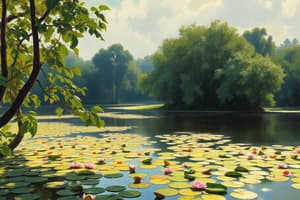Podcast
Questions and Answers
How would the removal of a keystone predator species most likely affect an ecosystem?
How would the removal of a keystone predator species most likely affect an ecosystem?
- Stabilization of prey populations and plant communities.
- Increased biodiversity due to more available resources.
- A trophic cascade leading to potential ecosystem collapse. (correct)
- Decreased competition among prey species for limited resources.
Which statement correctly describes the flow of energy and the cycling of matter within an ecosystem?
Which statement correctly describes the flow of energy and the cycling of matter within an ecosystem?
- Energy cycles through the ecosystem while matter is constantly supplied by external sources.
- Energy flows through the ecosystem in one direction, while matter is recycled. (correct)
- Energy is converted into matter, forming a closed loop within the ecosystem.
- Both energy and matter cycle indefinitely within the ecosystem without external inputs.
What is the primary role of decomposers in nutrient cycling within an ecosystem?
What is the primary role of decomposers in nutrient cycling within an ecosystem?
- Converting solar energy into chemical energy.
- Breaking down dead organic matter to release nutrients back into the environment. (correct)
- Absorbing nutrients directly from the soil for plant use.
- Consuming primary producers to release nutrients.
In the process of photosynthesis, what is the original source of the carbon atoms that make up a glucose molecule?
In the process of photosynthesis, what is the original source of the carbon atoms that make up a glucose molecule?
How do autotrophs contribute to the stability of an ecosystem?
How do autotrophs contribute to the stability of an ecosystem?
Which of the following best illustrates the concept of a trophic cascade?
Which of the following best illustrates the concept of a trophic cascade?
If a plant is exposed to a significantly reduced amount of sunlight, how would this most likely affect its ability to produce glucose?
If a plant is exposed to a significantly reduced amount of sunlight, how would this most likely affect its ability to produce glucose?
What happens to the oxygen produced during photosynthesis?
What happens to the oxygen produced during photosynthesis?
What role do primary consumers play in an ecosystem?
What role do primary consumers play in an ecosystem?
Which of the following is an example of matter cycling in an ecosystem?
Which of the following is an example of matter cycling in an ecosystem?
Flashcards
Photosynthesis
Photosynthesis
Converts solar energy into chemical energy, providing food and releasing oxygen.
Elements That Make Up Glucose
Elements That Make Up Glucose
Carbon, hydrogen, and oxygen combined to form energy for life.
Autotroph
Autotroph
An organism that produces its own food using photosynthesis.
Heterotroph
Heterotroph
Signup and view all the flashcards
Herbivores
Herbivores
Signup and view all the flashcards
Carnivores
Carnivores
Signup and view all the flashcards
Decomposers
Decomposers
Signup and view all the flashcards
Ecosystem Stability
Ecosystem Stability
Signup and view all the flashcards
Secondary Consumers
Secondary Consumers
Signup and view all the flashcards
Tertiary Consumers
Tertiary Consumers
Signup and view all the flashcards
Study Notes
- Photosynthesis uses carbon dioxide, water, and sunlight.
- Photosynthesis creates glucose and oxygen.
- The purpose of photosynthesis is to change solar energy into chemical energy.
- Photosynthesis provides food for autotrophs and releases oxygen.
Elements of Glucose
- Carbon originates from carbon dioxide absorbed from the air.
- Hydrogen originates from water molecules absorbed from the soil.
- Oxygen partly comes from carbon dioxide and water.
- Photosynthesis rearranges these elements into glucose.
- Glucose serves as an energy source for plants and other organisms.
Ecosystem Stability
- Ecosystem stability depends on organism interactions and nutrient recycling.
- Removing a predator can cause prey overpopulation
- Prey overpopulation can lead to overconsumption of plants or smaller organisms, disrupting the food web.
- Ecosystems rely on solar energy.
- Solar energy flows from producers to consumers and decomposers.
- Elements like carbon, nitrogen, and phosphorus cycle through organisms.
- Respiration, decomposition, and nutrient absorption facilitate this matter cycling.
Ecosystem Niches
- Predators control prey populations.
- Prey sustain predator populations.
- Autotrophs produce their own food through photosynthesis.
- Heterotrophs consume other organisms for energy.
- Primary consumers (herbivores) eat plants.
- Examples of herbivores are rabbits and deer
- Secondary consumers (carnivores/omnivores) eat herbivores.
- Examples of carnivores/omnivores are foxes and frogs
- Tertiary consumers are top predators, and they eat secondary consumers.
- Examples of top predators are wolves and hawks
- Decomposers break down dead organisms, recycling nutrients.
- Examples of decomposers are fungi, bacteria, and worms.
Studying That Suits You
Use AI to generate personalized quizzes and flashcards to suit your learning preferences.




